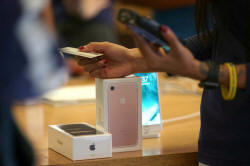|
Tech breakthroughs take a
backseat in upcoming Apple iPhone launch
 Send a link to a friend
Send a link to a friend
[February 23, 2017]
By Stephen Nellis
SAN
FRANCISCO (Reuters) - When Apple Inc launches its much-anticipated 10th
anniversary iPhone this fall, it will offer an unwitting lesson in how
much the smartphone industry it pioneered has matured.
The new iPhone is expected to include new features such as
high-resolution displays, wireless charging and 3-D sensors. Rather than
representing major breakthroughs, however, most of the innovations have
been available in competing phones for several years.
Apple's relatively slow adoption of new features both reflects and
reinforces the fact smartphone customers are holding onto their phones
longer. Timothy Arcuri, an analyst at Cowen & Co, believes upwards of 40
percent of iPhones on the market are more than two years old, a
historical high.
That is a big reason why investors have driven Apple shares to an
all-time high. There is pent-up demand for a new iPhone, even if it does
not offer breakthrough technologies.
It is not clear whether Apple deliberately held off on packing some of
the new features into the current iPhone 7, which has been criticized
for a lack of differentiation from its predecessor. Apple declined to
comment on the upcoming product.
Still, the development and roll-out of the anniversary iPhone suggest
Apple’s product strategy is driven less by technological innovation than
by consumer upgrade cycles and Apple’s own business and marketing needs.
"When a market gets saturated, the growth is all about refresh," said
Bob O’Donnell of Technalysis Research. "This is exactly what happened to
PCs. It's exactly what happened to tablets. It's starting to happen to
smartphones."
Apple is close-mouthed about upcoming product features, but analysts and
reports from Asian component suppliers and others indicate that
high-resolution displays based on OLED technology -- possibly with
curved edges -- are likely to be part of the anniversary phone. A
radical new design is not expected, according to analysts.
Some of the anticipated new technologies, notably wireless charging,
remain messy. Samsung Electronics Co Ltd <005930.KS> phones, for
example, feature wireless charging but support two different sets of
standards, one called Qi and the other AirFuel.
Apple recently joined the group backing Qi. But there are still at least
five different groups working on wireless charging technology within
Apple, according to a person with knowledge of the matter.
[to top of second column] |

A customer buys the new iPhone 7 smartphone inside an Apple Inc.
store in Los Angeles, California, U.S. on September 16, 2016.
REUTERS/Lucy Nicholson/File Photo
As to
3-D sensors, there is already one hiding in the iPhone 7. The front camera
features what is known as a time-of-flight sensor, which helps it autofocus and
is used in numerous phones including the Blackberry, according to TechInsights,
a firm that examines the chips inside tech devices.
That sensor could be upgraded to a higher-resolution version that could handle
3-D mapping for facial recognition, said Jim Morrison, vice president at
TechInsights.
Some analysts also speculate the company could remove the phone's home button,
placing it and a fingerprint sensor beneath the front display glass, based on
patents the company has filed.
SLOW GROWTH
Global smartphone sales were up only 2.3 percent to 1.47 billion units in 2016,
according to IDC. Many carriers in the United States have stopped subsidizing
phones, causing phone buyers to think harder about their next purchase.
Apple
will likely make a heavy marketing push around the phone’s 10th anniversary.
“IPhone set the standard for mobile computing in its first decade and we are
just getting started. The best is yet to come,” Chief Executive Officer Tim Cook
said in a statement Jan. 8, the date the iPhone was announced by then-CEO Steve
Jobs in 2007.
In 2015, the last year it disclosed the figure, Apple spent $1.8 billion on
advertising, up 50 percent from the year before and nearly four times the $467
million it spent in 2007 when it first released the iPhone.
And the company continues to excel at selling higher-priced phones. Chief
Financial Officer Luca Maestri attributed the most recent quarter's
record-setting 78.3 million iPhones sold to the iPhone 7 Plus, which for the
first time included a new dual camera feature not found in other models.
The iPhone 7 Plus tops out at $969 with memory upgrades and a jet black finish.
O'Donnell of Technalysis Research believes that with the next iPhone, Apple
might even introduce a $1,000-plus “ultra-premium device for the real
Apple-crazed folks out there who want to stand out."
(Reporting by Stephen Nellis; Editing by Jonathan Weber and Lisa Shumaker)
[© 2017 Thomson Reuters. All rights
reserved.] Copyright 2017 Reuters. All rights reserved. This material may not be published,
broadcast, rewritten or redistributed. |